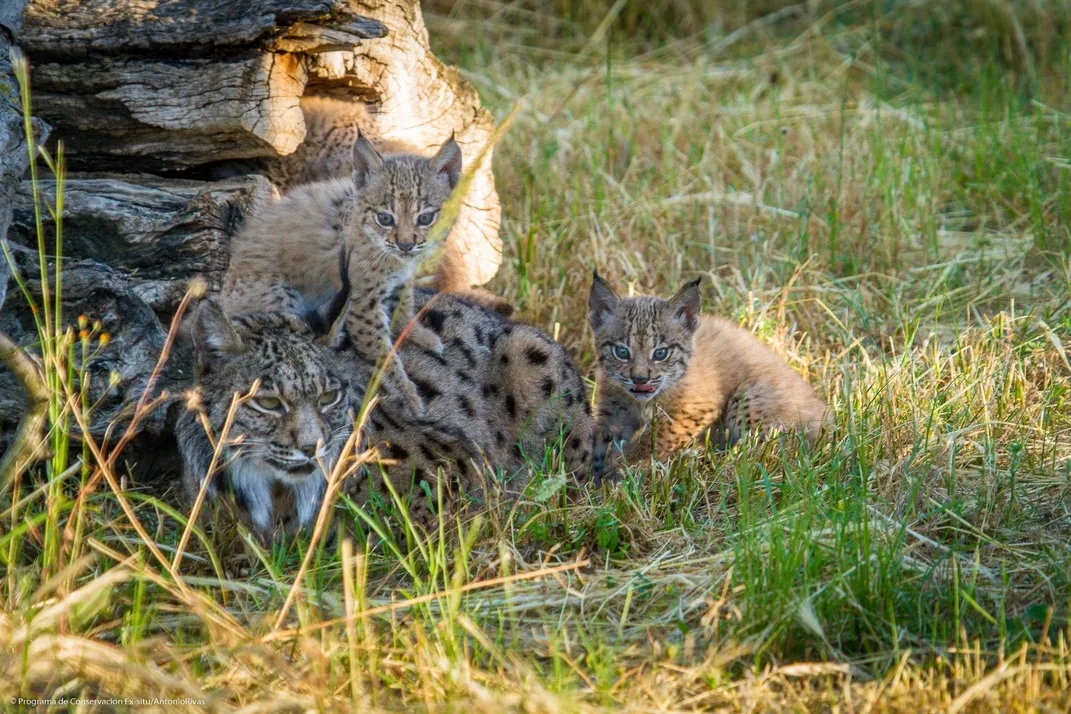How the Iberian Lynx Bounced Back From the Brink of Extinction
Two decades ago, fewer than 100 Iberian lynx remained, but thanks to captive breeding and habitat management, the population is recovering
:focal(982x289:983x290)/https://tf-cmsv2-smithsonianmag-media.s3.amazonaws.com/filer/17/b9/17b9b679-4937-4670-a7cc-6032219e9e7a/lynx1.jpg)
In the early 2000s, extinction seemed inevitable for the Iberian lynx.
The chances of spotting the short-tailed, bushy-bearded feline in the Iberian scrubland, where lynx have roamed for millennia, were as good as finding a needle in a haystack. The population was devastated by loss of prey, erosion of habitat, road accidents and hunting. In 2002, fewer than a hundred animals remained, the New York Times reported, and of those, only around a quarter were breeding females. However, against all odds, a conservation program has brought the Iberian lynx back from the verge of extinction.
The success of the LIFE+Iberlince program, involving more than 20 organizations, has brought the current count to almost 700 animals. “If someone told me 20 years ago that we would achieve such results, I would have thought they were out of their mind,” says Miguel Simón, the recently retired director of the Lynx LIFE program.
The recovery initiative is pillared by a breeding program and habitat safeguards. Prompted by the critically low numbers and partly funded by the European Union, the breeding program was initially an emergency strategy surrounded by uncertainty. According to Simón, scientists had little knowledge of lynx biology: would the animal be capable of adapting and breeding in captivity? And, if so, could a captive-bred lynx survive in the wild?
/https://tf-cmsv2-smithsonianmag-media.s3.amazonaws.com/filer/bf/88/bf88e7bc-c3a7-4d16-ad63-29294e4678d5/lynx2.jpg)
In hindsight, biologists had little to fear. Following the program’s implementation, the number of cubs soon exceeded the facilities’ capacity, and more centers were opened to house the animals. Over the years, nearly 500 hundred lynx were born across five captive breeding locations in Spain and Portugal: El Acebuche, La Olivilla, Silves, Zarza de Granadilla and Zoobotánico de Jerez. Though the captive lynx are divided across these five areas, scientists consider them a single population and have carefully distributed the animals to ensure maximum genetic diversity.
“Genetic diversity is key for the species’ survival,” says Rodrigo Serra, director of the Silves breeding center. “To better protect the lynx, we have to defend it at all costs. An even distribution across the centers gives us a greater guarantee that if something goes wrong in one facility, the impact for the species is minimized.”
As the lynx were progressively released into the wild, conservationists witnessed higher survival rates than expected—close to 70 percent during the first year—surpassing the estimates made on paper a decade ago by about 20 percent. The wild population was reduced to two isolated pockets at the turn of the millennium—one in Doñana National Park and another in the Sierra Morena mountains, both in southern Spain—but the release of captive-bred lynx allowed for the creation of six more pockets. No longer confined to an area of roughly 100 square miles, the lynx is now spread over a territory ten times bigger, with established populations in the Spanish regions of Andalusia, Castilla-La Mancha and Extremadura, and across the border in southern Portugal.

The success of the breeding program hinged on a simultaneous effort to safeguard the lynx’s territory. A specialist in both prey and habitat, the amber-eyed cat’s survival is intimately tied to the future of the Mediterranean scrubland, and to the survival of another local prey species: the rabbit. Historically, rabbits were highly abundant on the Iberian peninsula. The prominence of the rabbit is reflected in a theory attributing the origins of the peninsula’s Latin name—Hispania—to its earlier Carthaginian name meaning “land of the rabbit.” But after two viral illnesses, rabbit numbers have dwindled by up to 90 percent since the 1950s, says Paulo Alves, a professor at the University of Porto.
“Whenever the rabbit population has grown significantly, another virus strain strikes back,” says Eduardo Santos, from the Portuguese NGO Liga para a Protecção da Natureza. “We got used to the fluctuating rabbit numbers, and we are not alone in our efforts to stabilize the populations. The rabbit is crucial for the local ecosystem.”
Besides boosting rabbit numbers, the conservation of the Mediterranean scrubland has been, and will continue to be, a pivotal part of preserving the lynx. “Our greatest challenge is the scope of the project,” Santos says, “especially because the territory is mostly privately owned. We looked to sensitize the public to the importance of preserving the species and, after a rather slow start, people have proved tremendously supportive.”
Road kills are now responsible for more than half of lynx fatalities. This chief cause of non-natural deaths is proving difficult to resolve since roads crisscross the animal’s territory. Measures such as wildlife underpasses are being developed, but the problem will likely continue. “More lynx are dying on the roads than before, because there more lynx now,” Serra says.
Previously classified as critically endangered by the International Union for the Conservation of Nature (IUCN), the lynx’s status was downgraded to endangered in 2015, with the prospect of improving to vulnerable in about six years. At a time when extinction threatens so many species worldwide, the turnaround of the lynx’s fate is, unfortunately, an exceptional example. But more than an isolated case, Serra says, the beloved Iberian icon became a symbol of nature conservation across the peninsula and beyond.